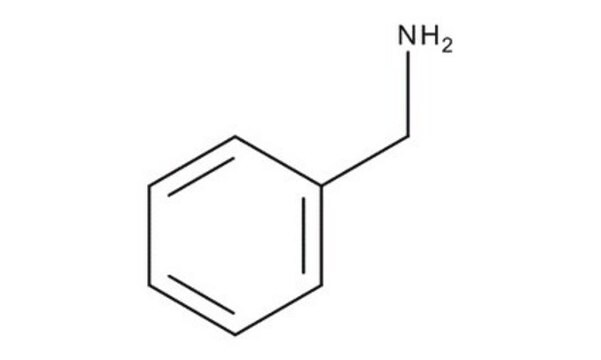Kluczowe dokumenty
241008
Phenethylamine
≥99%
Synonim(y):
2-Phenethylamine, β-Phenylethylamine, 2-Phenylethylamine
About This Item
Polecane produkty
gęstość pary
4.18 (vs air)
Poziom jakości
Próba
≥99%
Formularz
liquid
współczynnik refrakcji
n20/D 1.533 (lit.)
bp
197-200 °C (lit.)
rozpuszczalność
alcohol: freely soluble(lit.)
diethyl ether: freely soluble(lit.)
water: soluble(lit.)
gęstość
0.962 g/mL at 20 °C (lit.)
grupa funkcyjna
amine
phenyl
ciąg SMILES
NCCc1ccccc1
InChI
1S/C8H11N/c9-7-6-8-4-2-1-3-5-8/h1-5H,6-7,9H2
Klucz InChI
BHHGXPLMPWCGHP-UHFFFAOYSA-N
informacje o genach
human ... AOC3(8639)
mouse ... Aoc3(11754)
rat ... Htr2a(29595)
Szukasz podobnych produktów? Odwiedź Przewodnik dotyczący porównywania produktów
Opis ogólny
Hasło ostrzegawcze
Danger
Zwroty wskazujące rodzaj zagrożenia
Zwroty wskazujące środki ostrożności
Klasyfikacja zagrożeń
Acute Tox. 3 Oral - Eye Dam. 1 - Met. Corr. 1 - Skin Corr. 1B
Kod klasy składowania
6.1A - Combustible acute toxic Cat. 1 and 2 / very toxic hazardous materials
Klasa zagrożenia wodnego (WGK)
WGK 1
Temperatura zapłonu (°F)
177.8 °F - closed cup
Temperatura zapłonu (°C)
81 °C - closed cup
Środki ochrony indywidualnej
Faceshields, Gloves, Goggles, type ABEK (EN14387) respirator filter
Wybierz jedną z najnowszych wersji:
Masz już ten produkt?
Dokumenty związane z niedawno zakupionymi produktami zostały zamieszczone w Bibliotece dokumentów.
Nasz zespół naukowców ma doświadczenie we wszystkich obszarach badań, w tym w naukach przyrodniczych, materiałoznawstwie, syntezie chemicznej, chromatografii, analityce i wielu innych dziedzinach.
Skontaktuj się z zespołem ds. pomocy technicznej










